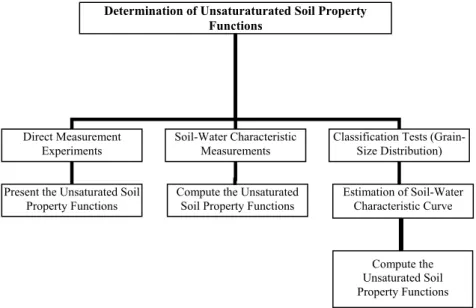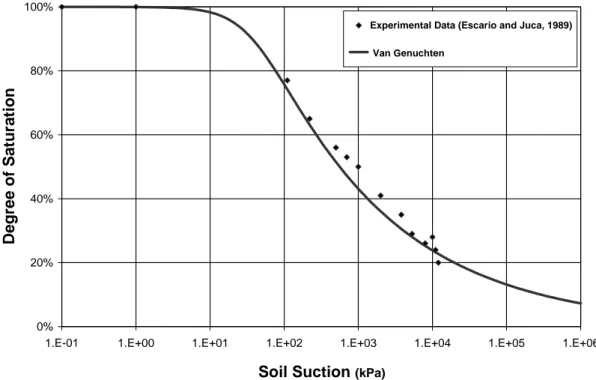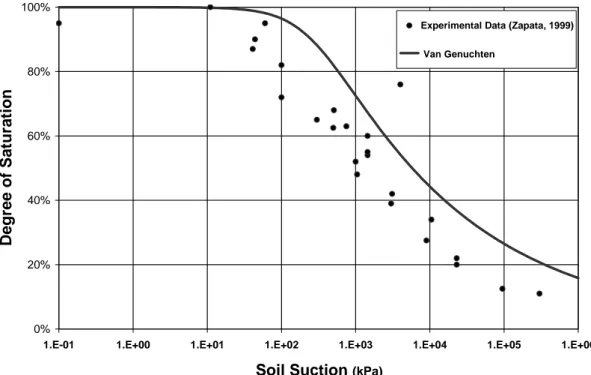A METHODOLOGY FOR ESTIMATION OF
SOIL WATER CHARACTERISTIC CURVE FOR
UNSATURATED COHESIVE SOILS
H. Ghasemzadeh
M. R. Abdi
N. Ganjian
K. Shakiba Nia
K. N. Toosi University of Technology, Tehran, Iran
ABSTRACTMany environmental issues involve transport of contaminants in unsaturated porous soil media. Unsaturated flow plays a significant role in wastewater infiltration and treatment. Transport of contaminants in unsaturated porous subsurface media is of significant importance due to the risks which contaminants pose to the environment. Mechanics of unsaturated soils is perhaps the most important issue in prediction of unsaturated flow including contaminant transport in the environment. The SWCC, “soil water characteristic curve”, can be used to determine various characteristics of the unsaturated soil media. In fact, it illustrates the relationship between soil suction and moisture content. Experimental methods for assessment of the SWCC are often time consuming and expensive. The SWCC can be estimated using specific characteristics of soils to avoid the costs of experimental methods. This paper aims at demonstrating that the SWCC for cohesive soils can be estimated using the PI, fine content, initial void ratio and the Van Genuchten equation.
KEYWORDS
Soil-Water Characteristic Curve, Unsaturated Soils, SWCC, PI, Cohesive Soils
1 INTRODUCTION
Unsaturated soil mechanics is increasingly attracting scientific attention, playing an important role in the prediction of contaminant transport in porous soil media. Unsaturated flow plays a significant role in wastewater infiltration and treatment. Mechanics of unsaturated soils is perhaps the most important issue in prediction of unsaturated flow including contaminant transport in the environment. The soil-water characteristic curve, “SWCC”, has also played a significant role in the study of unsaturated soils [1]. Knowledge of the soil water characteristic curve is fundamental for understanding unsaturated soils [19]. The SWCC illustrates the relationship between soil suction and moisture content. Fredlund and Morgenstern (1977) showed that the shear strength of unsaturated soils can estimated by any
The measurement of soil parameters used to describe behaviour of unsaturated soils is expensive, difficult and often impractical to obtain [6].
Figure 1 illustrates several approaches which can be taken to determine unsaturated soil property functions. Measurement of the soil-water characteristic curve for a soil can be used as an indirect laboratory test to compute an unsaturated soil property function [7].
Figure 1. Approaches that can be used in the laboratory to determine the unsaturated soil property functions [7].
The SWCC shows the relationship between soil suction and either the degree of saturation or the volumetric water content. The volumetric water content is the ratio of the water volume to the total volume as follows:
e e S n S V V V V V V t v v w t w + ⋅ = ⋅ = ⋅ = = 1 θ (1)
Where θ is the volumetric water content; VW, volume of the water within the soil; Vt, total volume of the soil; VV, volume of the pores within the soil; S, degree of saturation; n, porosity ratio; e, void ratio.
Figure 2 describes a typical plot of a soil-water characteristic curve which consists of three stages: capillary saturation, de-saturation and residual saturation. When the suction value exceeds the air-entry value, the degree of saturation decreases rapidly at relatively low suction values and then reduces more gradually when the suction becomes high [7].
Determination of Unsaturaturated Soil Property Functions
Direct Measurement Experiments
Soil-Water Characteristic Measurements
Classification Tests (Grain-Size Distribution)
Estimation of Soil-Water Characteristic Curve Compute the Unsaturated
Soil Property Functions Present the Unsaturated Soil
Property Functions
Compute the Unsaturated Soil Property Functions
Figure 2. Typical SWCCs [7].
Both empirical and theoretical investigations indicate that the SWCC is an essential element in unsaturated soil modelling and it is hysteretic in nature, owing to the energy dissipation during moving fluids in or out of the soil [14].
Many characteristics of unsaturated soils such as the coefficient of permeability, shear strength, pore size distribution and water content at any suction, can be obtained from the SWCC. Many researchers have tried to predict the SWCC, Gardner (1956), Brooks and Corey (1964), Brutsaert (1966), van Genuchten (1980), McKee and Bumb (1987), Burdine (1953), Mualem (1976), Kosugi (1994), Fredlund and Xing (1994). However there is still a need for further research on prediction of the SWCC since most of the models can not predict the SWCC accurately.
Zapata (2000) categorizes the predictive algorithms that can predict the SWCC based on grain size distribution and soil characteristics into three major approaches:
1- The approach which is based on statistical estimation of water contents at selected matric suction values.
2- The approach which includes the methods which correlate, by regression analysis, soil properties with the fitting parameters of an equation which represents the SWCC.
3- The approach which includes the methods that estimate the SWCC using a physics based conceptual model.
This paper aims at explaining that the SWCC of cohesive soils can be predicted using the PI, initial void ratio, fine content and the Van Genuchten (1980) equation.
2 VAN GENUCHTEN EQUATION
The Van Genuchten equation (1980) is widely used due to its flexibility. It can be written as equation 2. In this equation parameter b corresponds to the pore size distribution index. Parameter a does not affect the curve shape, but shifts the curve towards the higher or lower
c b a S ⎥ ⎥ ⎦ ⎤ ⎢ ⎢ ⎣ ⎡ ⎟ ⎠ ⎞ ⎜ ⎝ ⎛ + = ψ 1 1 (2)
Where S is the degree of saturation and ψ is soil suction.
Zapata (2000) suggested that of cohesive soils, the product of the percentage passing # 200 sieve, as a decimal, multiplied by the PI as a percentage, can be used to form the weighted PI, “W.PI”. The equilibrium soil suction at a given degree of saturation is expected to be proportional to the specific surface area of the soil. The PI is a fair indicator of surface area and the use of PI alone can be considered. However, a soil with a small percentage of highly active clay would have a high PI but only a moderate specific surface area. Therefore, the weighted PI (W.PI) can be considered a better index of soil particle surface area for predicting the Soil-Water Characteristic Curve [22].
The smaller the initial void ratio, “e”, the higher the air-entry value, “AEV”, and the higher the residual degree of saturation as well [12]. The air-entry value and the residual degree of saturation can be expressed together by void ratio, “e”, using empirical relationships. The air-entry value is an important parameter for partially saturated soils since the degree of saturation starts to drop rapidly when the suction exceeds the AEV. The denser the soil, the higher the AEV, which implies that for soils with low void ratio values, small changes in degree of saturation can be assumed at low suctions [11].
3 ESTIMATION OF THE SWCC FOR COHESIVE SOILS
The following equations have been driven by fitting the Van Genuchten Equation (1980) to experimental observations. The parameters a, b, and c, are assumed to be functions of the PI, initial void ratio and the percentage passing sieve # 200 (see equation 2).
( . ) 0.1028( . ) 0.5871( . ) 4.118.(1 ).(1/Ln(0. 75+ )) 11.813 0015 . 0 3 + 2 + + − + = W PI W PI W PI W e a (3)
(
.)
0.01358(
.)
1.76987 00011 . 0 2 − + = W PI W PI b (4)(
.)
0.00014(
.)
0.376.(1 ).Ln(0.75 + )+0.14745 10 5 6 W PI 2 W PI W e c = − × − − + − (5)Where W is the percentage passing sieve # 200; e, initial void ratio; PI, plasticity index as a decimal.
Results from these equations have been compared to those from experimental observations. Figures 3 through 7 show the results. Table 1 shows the characteristics of the soils and the parameters of the Van Genuchten equation, calculated using the above equations.
Table 1. The Characteristics of the Soils and the Parameters of the Van Genuchten Equation. Parameters of Equation (2) Soil γd (gr/cm3) PI (%) W e a b c
Madrid Gray Clay
1.33 31 0.98 1.03 166.73 1.467 0.143
Red Silty Clay
1.80 14 0.83 0.48 38.25 1.627 0.158
Madrid Clayey Sand
1.91 0.138 0.38 41.85 1.756 0.18747
Fountain Hills Clay
1.14 35 0.92 1.386 261.2 1.46 0.158
Price Club Clay
1.33 0.5364 1.053 16.79 1.741 0.249 0% 20% 40% 60% 80% 100%
1.E-01 1.E+00 1.E+01 1.E+02 1.E+03 1.E+04 1.E+05 1.E+06
Soil Suction (kPa)
Degr ee of S a tur a tion
Experimental Data (Escario and Juca, 1989) Van Genuchten
0% 20% 40% 60% 80% 100%
1.E-01 1.E+00 1.E+01 1.E+02 1.E+03 1.E+04 1.E+05 1.E+06
Soil Suction (kPa)
De gr ee of S a tu ra tion
Experimental Data (Escario and Juca, 1989) Van Genuchten
Figure 4. Experimental and Estimated SWCCs (Red Silty Clay).
0% 20% 40% 60% 80% 100%
1.E-01 1.E+00 1.E+01 1.E+02 1.E+03 1.E+04 1.E+05 1.E+06 Soil Suction (kPa)
D e gre e of Sa tur a ti on
Experimental Data (Escario and Juca, 1989) Van Genuchten
0% 20% 40% 60% 80% 100%
1.E-01 1.E+00 1.E+01 1.E+02 1.E+03 1.E+04 1.E+05 1.E+06
Soil Suction (kPa)
De gr e e of S a tura tio n
Experimental Data (Zapata, 1999) Van Genuchten
Figure 6. Experimental and Estimated SWCCs (Fountain Hills Clay).
0% 20% 40% 60% 80% 100%
1.E-01 1.E+00 1.E+01 1.E+02 1.E+03 1.E+04 1.E+05 1.E+06
Soil Suction (kPa)
Degr ee of S a tu rati on
Experimental Data (Zapata, 1999) Van Genuchten
4 CONCLUSIONS
Three equations have been developed through fitting the Van Genuchten equation (1980) to experimental results to show that the SWCC of cohesive soils can be predicted using the PI, fine content, initial void ratio and the Van Genuchten equation. Results show that for cohesive soils, the parameters of the Van Genuchten equation, “a”, “b”, and “c”, are functions of the PI, initial void ratio and the percentage passing # 200 sieve.
REFERENCES
[1] Barbour, S.L., 1998. "Nineteenth Canadian Geotechnical Colloquium: The soil-water characteristic curve: a historical perspective." Canadian Geotechnical Journal, 35: 873–894. [2] Brooks, R.H. and Corey, A.T., 1964. "Hydraulic properties of porous media." Hydrology Papers, 3. Fort Collins, Colorado State University.
[3] Brutsaert, W., 1966. “Probability laws for pore size distribution.” Soil Science, 101:85-92. [4] Burdine, N.T., 1953. “Relative permeability calculations from pore size distribution data.” Journal of Petroleum Technology, 5:71-78.
[5] Escario, V. and Juca, J.F.T. 1989. “Strength and Deformation of Partly Saturated Soils”, Proceedings of the Twelfth International Conference on Soil Mechanics and Foundation Engineering, Vol. 2, pp. 43-46.
[6] Fredlund, D.G. 1995. “The prediction of unsaturated soil property functions using the soil-water characteristic curve.” In Proceedings of the Bengt Broms Symposium in Geotechnical Engineering, Singapore, 13–16 Dec., pp. 113–133.
[7] Fredlund, D.G., 2000. "The implementation of Unsaturated Soil mechanics into geotechnical engineering.", Can. Geotech. J., 37:963-986.
[8] Fredlund, D.G., and Morgenstern, N.R. 1977. “Stress state variables for unsaturated soils.” Journal of the Geotechnical Engineering Division, ASCE, 103(GT5): 447–466.
[9] Fredlund, D.G., and Xing, A., 1994. "Equations for the Soil-Water Characteristic Curve", Canadian Geotechnical Journal, 31(3): 521-532.
[10] Gardner, W., 1956. “Mathematics of isothermal water condition in unsaturated soils.” Highway Research Board Special Report 40 International Symposium on Physico-Chemical Phenomenon in Soils. Washington D.C., p.78-87.
[11] Jian, Z., and Jian-lin, Y., 2005. " Influences affecting the soil-water characteristic curve.", Journal of Zhejiang University SCIENCE, 6A(8):797-804.
[12] Kawai, K., Karube, D., and Kato, S., 2000. “The model of water retention curve considering effects of void ratio.” In: Rahardjo, H., Toll, D.G., Leong, E.C.(Eds.), Unsaturated Soils for Asia. Balkema, Rotterdam, p.329-334.
[13] Kosugi, K., 1994. “The parameter lognormal distribution model for soil water retention.” Water Resource Research, 30:891-901.
[14] Li, X., 2005. “Modelling of hysteresis response for arbitrar wetting/drying paths.” Computers and Geotechnics, Volume 32, Issue 2, March 2005: 133-137.
[15] McKee, C., Bumb, A., 1987. “Flow-testing coalbed methane production wells in the presence of water and gas. SPE Formation Evaluation, (10):599-608.
[16] Mualem, Y., 1976. “A new model for predicting the hydraulic conductivity of unsaturated porous media.” Water Resources Research, 12:593-622.
[17] Nam, S., Gutierrez, M., Diplas, P., Petrie, J., Wayllace, A., Lu, N., Muñoz, J. J., .”Comparison of testing techniques and models for establishing the SWCC of riverbank soils .” Engineering Geology, Volume 110, Issues 1-2, 2010: 1-10.
[18] Nuth, M. and Laloui, L., 2008. “Advances in modelling hysteretic waterretention curve in deformable soils.” Computers and Geotechnics
Volume 35, Issue 6, November 2008, 835-844.
[19] Prunity , L. and Bell , J., 2007. “Soil Water Hysteresis at Low Potential.” Pedosphere, Volume 17, Issue 4, August 2007, 436-444.
[20] Van Genuchten, M.T., 1980. "A closed-form equation for predicting the hydraulic conductivity of unsaturated soils." Soil Science Society of America Journal, 44:892-898. [21] Zapata, C.E., 1999. "Uncertainty in soil-water characteristics curve and impact on unsaturated shear strength predictions." Ph.D. Dissertation, Arizona State University, Tempe, United States.
[22] Zapata, C. E., Houston, W.N., Houston, S.L, and Walsh, K.D., 2000. “Soil-water characteristic curve variability.” In: Proceedings of Advances in unsaturated geotechnics, Sessions Geo-Denver 2000: 84-121.

![Figure 2. Typical SWCCs [7].](https://thumb-eu.123doks.com/thumbv2/5dokorg/3689007.45857/3.892.284.606.135.325/figure-typical-swccs.webp)


